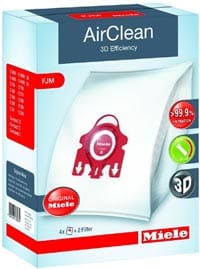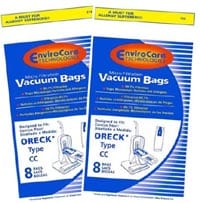 Bagged vacuum cleaners store dirt and debris locally in dirt bags during cleaning. When buying such a vacuum cleaner, original vacuum bag(s) are delivered with the device, but after some time, one has to buy new ones. There are many things to consider when buying vacuum cleaner bags, but the first question is: generic or genuine vacuum bag? One may not think this is even an issue. After all, what could OEM vacuum cleaner bags have in comparison to the generic ones? As long as it fits, a bag is a bag. But is it, really?
Bagged vacuum cleaners store dirt and debris locally in dirt bags during cleaning. When buying such a vacuum cleaner, original vacuum bag(s) are delivered with the device, but after some time, one has to buy new ones. There are many things to consider when buying vacuum cleaner bags, but the first question is: generic or genuine vacuum bag? One may not think this is even an issue. After all, what could OEM vacuum cleaner bags have in comparison to the generic ones? As long as it fits, a bag is a bag. But is it, really?
To answer that question, there are few things to discuss about disposable and reusable vacuum cleaner bags of the original or the generic kind.
Disposable or Reusable Vacuum Cleaner Bags
When filled with dirt, disposable bags are thrown away and a new, clean one is placed into the vacuum. Reusable vacuum bags are emptied and used again until filled again and the cycle continues until the reusable bag gets damaged.
Obviously, reusable bags can be made with quality in mind and can be more expensive than disposable bags, but the emptying of reusable bags is often a messy job.
On the other hand, disposable bags are simply thrown away when they become full and replaced with a new one – this can be quite costly if you have a large area that has to be vacuumed often.
Vacuum Cleaner Bags’ Filtration Level
 The air that enters the vacuum, must come out into the cleaner area. Most bagged vacuums have several filters for air filtration, with vacuum bags being first and often the most important ones. The main home bagged vacuum cleaner should have at least two or even three filters.
The air that enters the vacuum, must come out into the cleaner area. Most bagged vacuums have several filters for air filtration, with vacuum bags being first and often the most important ones. The main home bagged vacuum cleaner should have at least two or even three filters.
The first one is the dirt bag, the second is a mechanical filter in front of the motor and a third one is a filter after the motor that is often a HEPA grade filter.
Vacuums that have HEPA level of filtration, but only two filters, use the second filter as HEPA level filter.
- HEPA filters remove at least 99.97% of particles 0.3 micrometers in size.
- Some HEPA filters are washable, but even they should be replaced after some time, and that costs money.
If one uses dirt bag of low quality, that means that more small particles (pollen, dust, sand, bacteria, spores, dust mites, allergens, etc) will pass it and end up in the second filter (being HEPA or not) or maybe will be even returned back in the cleaned area.
A Few Notes on HEPA Vacuum Bags
Most of the cheap disposable bags are marketed as having 99.7% filtration level.
It means that they filter 997 out of 1000 particles from the exhaust air, leaving 3 particles (out of 1000) for the next filter to remove from the air. These 3 particles don’t sound much, but for people with asthma and various allergies, even they can be a problem. Also, many of these bags don’t define the size of the particles that are removed from airflow.
HEPA filters remove 9997 out of 10000 particles from exhaust air, according to the United States Department of Energy standard, while European Union has several HEPA classes of HEPA filtration (let us stick to US standard). That means that there are 3 particles (out of 10000) that must be removed from air by the next level of filtration.
This 10 fold better filtration is perhaps not much for people with asthma and allergies, but this time, the size of the particles is defined – 0.3 micrometers or larger.  The size of dirt particles commonly found in human-environment are:
The size of dirt particles commonly found in human-environment are:
- bacteria 0.3-10.0 micrometers,
- pollen 10.0-100.0 micrometers,
- pet and human hair 30.0-200.0 micrometers,
- dust mites 90.0-600.0 micrometers,
- sand 50.0-1000.0 micrometers, etc.
Having this in mind, it is obvious how important is good filtration already at the dirt bag level.
What Else Should You Know about Vacuum Cleaners’ Bags?
Vacuum bags that have HEPA grade air filtration cost more than ordinary bags, but if the cleaned area is not an office building or hotel, it is a good investment, even if you prefer disposable HEPA bags.
We have mentioned European Union filtration standards with a good reason – there are vacuum bags that meet US HEPA standard with ease and those bags are often marketed as ‘odor remover’ bags.
Such bags have a layer of activated charcoal, often between several layers of spun fiber material creating ‘depth (3D) air filter’. Those bags are disposable, they obviously cost more than ordinary paper disposable bags, but they remove even odors from the exhaust air. People with kids, pets, asthma, allergies, and similar should seriously consider the best vacuum cleaners for asthma and allergies and – additionally – such specialized bags.
Note that bagless vacuum cleaners that use dirt canisters and bins, can use mechanical air filters with the same level of air filtration. Such filters without activated charcoal are often washable. Of course, second filtration level filters in bagged vacuums can use the same filters.
How to Choose and How to Use the Best Vacuum Cleaner Bags
- Regardless if made out of paper or clothes or some other material, as bags are filled, they lower the suction level of vacuum cleaner because of the pressure drop. Most of the vacuums have warning lights that caution the user that the bag is full.
- HEPA and similar filters often have higher pressure drop when compared with ‘ordinary’ filters.
- The dirt bags must fit perfectly in the vacuum cleaner, otherwise, exhaust air can pass the bag.
- Reusable bags must be cleaned thoroughly, without the dirt being left inside of the dirt bag.
- Cleaning of moist dirt should be avoided, but if done so, dirt bag must be emptied right away, even if it is made out of clothes or impregnated paper. Disposable bags should be thrown away, while reusable bags should be emptied and if necessary, left outside to dry out.
Generic vs Genuine Vacuum Cleaner Bags
 Which one to buy, generic, or genuine vacuum bags?
Which one to buy, generic, or genuine vacuum bags?
Generic bags are cheaper, often fits as good as genuine bags, but their filtration level rarely can keep up with the filtration level of genuine vacuum bags.
Due to the lower filtration level, second level filters get dirty more quickly and have to be cleaned or replaced more often. If not, higher pressure drops will occur leading to decreased level of suction.
Although this sound grim, in real life, areas that are not often walked over and that doesn’t get dirty quickly can be vacuumed thoroughly using disposable generic vacuum bags, without stressing second layer air filters, at the fraction of the cost of genuine vacuum bags.
People with small kids, pets, asthma, allergies, and similar should use high-quality generic bags or preferably genuine bags. Such homes require high performance, main vacuum cleaners to clean the home regularly and that comes with a price. Cheap bags can lower the costs in the beginning but can cause other problems with both health and with a vacuum cleaner itself.
What Type of Vacuum Cleaner Bags do You Use?
Have you ever considered buying original vacuum cleaner bags versus generic ones? Which type do you use in your home? Share your experience with us and give us your tips and opinions on this matter!

With a degree in engineering, Kathryn Hansen loves to write about how things work. Having her own dilemmas on how to pick the best vacuum cleaner for her large family (with a handful of furry four-legged members as well), Kathryn decided to help others in the same situation. After all, vacuum cleaners are critical to a healthy lifestyle and people have a hard time choosing the best one for their needs.
